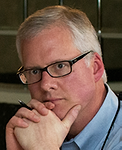This summer, my dad (Frank), Darren Foster and I tagged along with the first group of VIP dealers and customers that converged on Downs, Ill., for a look at Horsch’s brand new Ag Vision Farm, which was purchased earlier this year from Beck’s Hybrids.
We’d heard about founder Michael Horsch’s plans for an educational farm that would experiment with controlled traffic, cover crops, precision seeding, crop rotations and diversity, including bringing canola into the state.
If you’ve ever heard this candid farmer and shortline equipment manufacturer speak, you won’t forget it. A little background...
- He invested in a 100,000 square foot greenfield facility in Mapleton, N.D., 5 years ago, followed by the introduction of a high-speed corn planter. The manufacturer intends to increase its U.S. presence by 4 times (to $100 million) in the next 5 years.
- He intends to realign the manufacturer-farmer-dealer triangle for his equipment and is willing to do his part to support dealers willing to look beyond the iron.
- He needs dealers but won’t chase them. While Horsch has major players like Butler Machinery, we’ve also seen the company sign up small, independent dealers, even farmer-dealers, who can make up for their lack of distribution with agronomic knowledge.
- He’s been known to play chicken with John Deere, including the booting of green dealers out of his network overseas.
He’d rather talk about his farms than the equipment designs that spurred a $600 million global manufacturing operation. Many of you tuned in to our “How We Did It” podcast with him, but it covered only part of this late-night interview. Horsch was on a roll, and eager to call “B.S.” on some trends in farming.
You can find more at www.farm-equipment.com/MichaelHorsch, but much of it boils down to “air-conditioned workshops paid for by $7 corn,” over-reliance on consultants and a preoccupation with stockpiling computing technology.
The revelation came to him through his farm benchmarking group, and how one farmer was banking 4 times more profit per acre with no significant variables. He discovered that high-profit farmer in the group was operating with 10 times fewer gigabytes of computing power than his peers.
He maintains that it’s the multi-talented farm owner/operator that makes the difference — the “one who owns all of the decisions with no in-betweens,” he says. “We’re talking about a $200 per acre kind of advantage.
“The higher the level of digitalization on the farm, the lower the bottom line.”
His revelation was verified by his two sons, to whom he handed the management of an 8,000-acre farm — who then proceeded to question his operating skills. He had to reassign the farm manager to another job. His sons suspended all management software, imaging and layered screens of prescriptions, and simply hung a white-erase board. They kept only one crop consultant and at 1 day a week during the season — to walk (not drive) the fields with them. Their sprayed acres went down substantially, and often at half the rate. The friction the boys were causing was healed when Dad saw that they had — in 15 months — taken $250/acre in expense out, or $2 million.
Horsch had no choice but to sell with a spade when he got started in farm equipment. And he thinks the stakeholders getting further away from the action at seeding and when the crop is growing is hurting farm profits by the hundreds of thousands of dollars.
He illustrates a good point, and I found myself wondering how you replace intuition and experience — because you use it, or you lose it.
“What we need are boots,” Horsch says, “not gigabytes.”
Check out the videos and in-depth podcast at www.farm-equipment.com/MichaelHorsch.







